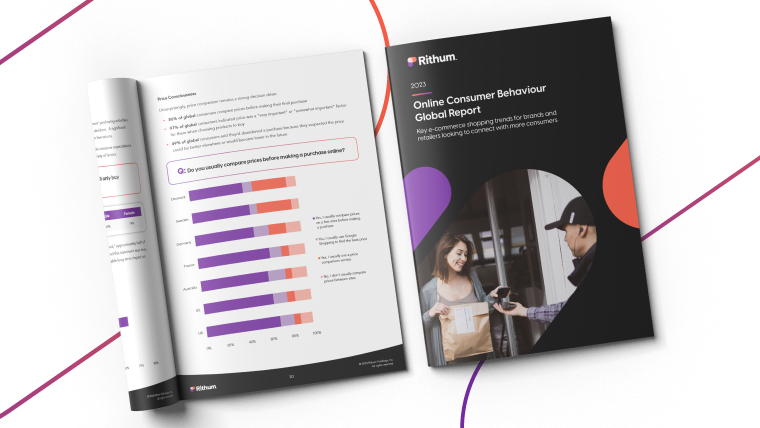What do consumers want? How do their expectations change across the globe? What can you do to make your e-commerce program thrive in the coming year?
Brands and retailers spend their whole careers chasing down answers to these questions — but we’ve revealed them in our 2023 global online survey results.
Our 2023 Online Consumer Behavior Global Report covers the trends shaping global e-commerce today with survey findings (in partnership with Dynata) from over 6,000 consumers worldwide. The report reveals insights on everything from search and discovery habits to delivery and return expectations.
If you missed our recent webinar on the report findings, here’s a recap of the four biggest trends facing today’s e-commerce industry across the US, UK, Germany, France, Sweden, Denmark and Australia.
Trend 1: Consumers Take a Multichannel Approach
The majority of online shoppers (72%) now visit between two and four websites (whether search engines, marketplaces or brand websites) on their buying journey. Consumer electronics buyers are the most savvy shoppers, as an astounding 91% visit two or more sites before purchase.
This indicates increasing fragmentation in an already fragmented industry. Consumers are consistently shopping around to find the best product quality, prices and customer experience — and they’re willing to jump ship at the first sign of subpar selling.
Our recommendation? Join them in their multichannel approach. It doesn’t necessarily mean you must extend your presence to hundreds of marketplaces. Instead, use a diverse set of tactics including retail media and social media marketing to simply remind shoppers of your brand. After all, a whopping 89% of consumers across age groups now “window shop” on retail sites without the direct intent to purchase.
Trend 2: Marketplaces Dominate Online Shopping
Consumers across the globe are increasingly comfortable shopping on marketplaces. Like an online department store, marketplaces are a “one-stop shop” for consumers, offering diverse product catalogues, safe transactions and convenient ordering. German consumers are among the heaviest marketplace users, as 83% regularly visit multiple marketplaces. Thirty percent of Swedish consumers even visit four or more online marketplaces at a time.
It’s not all about purchasing, though. Marketplaces have become popular destinations for browsing, shopping and buying. Of course, this fluctuates by age, as more than 75% of consumers under 45 conduct these diversified marketplace activities on two or more channels.
It may also depend on a consumer’s desired product, as 84% of consumers regularly use multiple marketplaces to browse, shop and buy when looking for:
- Consumer electronics
- Home furniture
- Sporting goods
- Automotive
- Jewelry and watches
Trend 3: Retail Media Is an Integral Part of the Buying Cycle
It’s not news that retail media has taken off in recent years. But what’s starting to evolve is consumers’ awareness and comfort level with marketplace ads. In fact, 62% of consumers age 18-25 and 58% of consumers age 26-35 say they’ve clicked on sponsored or promoted ads in the last year.
It could be because digital ads are now expected at the point of sale, much like candy at the checkout counter. But, more likely, it could be because ads are now more curated than ever, increasing relevance in the minds of consumers.
Do ads just encourage clicks, or do they actually result in purchases? Our survey data shows 40% of consumers across the world have purchased a product on Amazon after seeing an ad for the item. That number increases in the US (51%), the UK (44%), France (42%) and Germany (47%) — markets where Amazon is a top marketplace.
Trend 4: Easy and Free Returns Are a Top Consumer Priority
Clicking “purchase” is never the end of a transaction. Consumers are still on the lookout for how fast the item is delivered and whether or not you continue to engage them after the sale. The post-purchase process has become so important that consumers now make decisions based on how easy returns will be.
Across the globe, 71% of consumers now say they will only buy items from sites that offer free returns. Some consumers choose to skip the returns process altogether. Australians are among the most fickle, as 65% say they sometimes don’t engage in the process because it’s too complicated.
Does an unwillingness to return purchases mean good news for sellers? Not necessarily. A poor customer experience, whether leading to the purchase or post-transaction can cause a consumer to abandon their brand relationship together, forfeiting future sales.
E-Commerce Insights That Will Shape the Coming Year
There’s a lot more where these stats come from. In our full report, we explore:
- How social media is increasingly influencing product discovery
- How consumers typically respond to out-of-stocks
- What factors (e.g., price, two-day shipping, click-and-collect options) are most essential for conversions
- Where consumers plan to do their 2023 holiday shopping
Download the full report or watch the on-demand webinar for all the e-commerce insights you need to build a winning strategy for the coming year.

